Andhra Pradesh BIEAP AP Inter 1st Year Botany Study Material 5th Lesson Morphology of Flowering Plants Textbook Questions and Answers.
AP Inter 1st Year Botany Study Material 5th Lesson Morphology of Flowering Plants
Very Short Answer Questions
Question 1.
Differentiate fibrous roots form adventitious roots. [T.S. May, 18]
Answer:
| Fibrous roots | Adventitious roots |
| Several number of roots originate from the base of the stem called fibrous roots. | Roots that arise from parts of the plant other than the radicle are called Adventitious roots. |
Question 2.
Define modification. Mention how root is modified in Banyan tree and mangrove plants.
Answer:
Modification is defined as “A permanent morphological change in an organ in order to perform a special function”. In banyan tree, roots develop from the huge branches and grow into the soil become pillar like called prop roots or piller roots. In Mangroves – Many roots come out of the ground, grow vertically upwards called Pneumatophores, or Respiratory roots help in gaseous exchange.
Question 3.
What types of specialized roots are found in Epiphytic plants? What is their function?
Answer:
In Epiphytic plants, velamen roots are present. They help in absorption of moisutrefrom atmosphere.
Question 4.
How does the sucker of chrysanthemum differ from the stolon of Jasmine?
Answer:
| Sucker | Stolon |
| The lateral branches originate from the basal and underground portion of the stem grow horizontally beneath the soil and then come out obliquely upward giving rise to leafy shoots. Ex : Chrysanthemum, Mentha. |
A slender lateral branch arises from the base of the main axis, grow aerially, arches downwards to touch the ground and produce adventitious roots. Ex : Jasmine, Nerium. |
Question 5.
What is meant by pulvinus leaf base? In members of which angiospermic family do you find them? [A.P. May, 18, 17. Mar, 14]
Answer:
The swollen leaf base is called pulvinous leaf base. It is seen is “Leguminasae” family.
![]()
Question 6.
Define venation. How do Dicots differ from Monocots with respect to venation. [A.P. Mar, 15]
Answer:
“The arrangement of veins and the veinlets in the lamina of the leaf” is called venation.
In Dicots, Midrib, lateral veins and veinlets form a network so called Reticulate venation.
In Monocots, the veins run parallel to each other within a lamina so called parallel venation.
Question 7.
How is Pinnately compound leaf is different from a palmately compound leaf? Explain with one example each.
Answer:
Lamina is divided into leaflets which are arranged on either side of the rachis is called pinnately compound leaf.
Ex : Neem
Lamina is divided into leaflets, which are arranged at the tip of the petiole, called Palmately compound leaf.
Ex : Bean, Citrus.
Question 8.
Which organ is modified to trap insects in Insectivorous plants? Give two examples. [Mar, 13]
Answer:
In Insectivorous plants, leaves (Lamina) are modified to trap insects.
Ex : Nepenthes, Drosera.
Question 9.
Differentiate between Racemose and Cymose inflorescences. [T.S. Mar, 15]
Answer:
| Racemose Inflorescence | Cymose Inflorescence |
| 1. Peduncle grows Indefinitely. | 1. Peduncle grows definitely. |
| 2. Flowers are arranged in Acropetal manner. | 2. Flowers are arranged in Basipetal manner. |
Question 10.
What is the morphology of cup like structure in Cyathium? In which family it is found?
Answer:
In Cyathium, cup like structure is formed from Involucre of Bracts. It is seen in “Euphorbiaceae” family.
Question 11.
What type of Inflorescence is found in fig trees ? Why does the insect Balstophaga visits the Inflorescence of fig tree?
Answer:
In ‘Fig’ trees, ‘Hypanthodium’ Inflorescence is seen. An Insect called ‘Blastophaga’ visits this inflorescence, because it lay its eggs in the gall flowers.
Question 12.
Differentiate actinomorphic from zygomorphic flower.
Answer:
| Actinomorphic Flower | Zygomorphic Flower |
| “A Flower that can be cut into two equal halves in any vertical plane”. Ex : Datura, Hibiscus. |
“A flower that can be cut into two equal halves in one vertical plane”. Ex : Bean, Crotalaria. |
Question 13.
How do the petals in pea plant are arranged? What is such type of arrangement called?
Answer:
In Pea and Bean Flowers, there are five petals. The largest petal (standard) overlaps the two lateral petals (wings) which in turn overlap the two smallest anterior petals (Keel). This type of aestivation is called Descendingly Imbricate aestivation. This type of corolla is called vexillary or papilionaceous corolla.
Question 14.
What is meant by eipetalous condition? Give an example.
Answer:
When the stamens are attached to the petals that condition is called Epipetalous condition.
Ex : Brinjal, Datura.
Question 15.
Differentiate between apocarpous and syncarpores ovary.
Answer:
| Apocarpous ovary | Syncarpores ovary |
| “When more than one carpel is present in a ovary, they may be free” Ex : Rose |
When morethan one carpel is present in a ovary, they are fused. Ex : Tomato |
Question 16.
Define placentation. What type of placentation is found in Dianthus. [T.S. Mar, 15]
Answer:
“The arrangement of ovules with in the ovary is known as placentation”. In Dianthus – Free Central placentation is seen.
Question 17.
What is meant by parthenocarpic fruit? How is it useful?
Answer:
The fruit which is formed without fertilization of the ovary is called parthenocarpic fruit. They are useful commercial production of seedless fruits and also useful in Juice Indus tries.
Question 18.
What is the type of fruit found in mango ? How does it differ from that of coconut?
Answer:
In Mango, the type of fruit is Drupe. In Mango Epicarp is thin, Mesocarp is fleshy and edible and endocarp is stony. Where as in coconut, the mesocarp is fibrous.
![]()
Question 19.
Why certain fruits are called false fruits? Name two examples of plants having false fruits. [T.S. May, 18. Mar, 13]
Answer:
Fruits which are formed form other parts of the flower along with ovary are called false fruits.
Ex : Apple – Thalamus develops into false fruit.
Cashewnut – Pedicel develops into False fruit,
Question 20.
Name any two plants having single seeded dry fruits.
Answer:
(1) Rice (Caryopsis) (2) Cashew nut (nut) (3) Tridax (Cypsela)
Question 21.
Define Schizocarpic dry fruits. Give an example.
Answer:
The fruits which split into one-seeded bits, called mericarps and are called Schizocarpic fruits.
Ex : Acacia, Castor. ,
Question 22.
Define mericarp. In which plant you find it?
Answer:
The one seeded bits of Schizocarpic fruits are called mericarps.
Ex : Acacia.
Question 23.
What are aggregate fruits? Give two examples. [A.P. May, 18]
Answer:
In custard apple. Many carpels are present. Each carpel of apocarpous gynoecium develops into a fruitlet. Such bunch of fruitlets are called aggregate fruits.
Ex : Annona, Naravalia.
![]()
Question 24.
Name a plant that has single fruit developing from the entire inflorescence. What is such a fruit called? [Mar, 14]
Answer:
Pine apple. This fruit is called composite fruit.
Short Answer Type Questions
Question 1.
Explain different regions of root with neat labelled diagram.
Answer:

The tip of the root is covered by Thimble like structure called root cap which protect the root apex. A few m.m above the root cap, meristematic zone is present which consists of small, thin walled cells with dense protoplasm. These cells divide repeatedly. The cells proximal to this zone undergo rapid elongation and enlargement and are responsible for growth of the root in length.
This region is called elongation region. The cells of the elongation zone gradually differentiate and mature so called maturation zone. From this zone, some of the epidermal cells form very thin and delicate thread like structures, called root hairs which help in absorption of water and Minerals from the soil.
Question 2.
Justify the statement, “Underground parts of plants are not always roots”.
Answer:
In some plants, stems are underground and help in storage of food materials, organs of perennation to tide over unfavourable conditions, vegetative propagation and also protect themselves form grazing animals. More over, underground stems bear nodes, internodes, buds and scale leaves. Because of this, they are treated as stems but not roots, so underground parts of plants are not root.
Ex : Stem tuber of Potato, Rhizome of Zinger, Turmeric, corm of Amorphophallus, Colocasia and Bulb of onion.
Question 3.
Explain with examples different types of phyllotaxy.
Answer:
Arrangement of leaves on the stem or on the branchs is called Phyllotaxy. It is of three types.
A) Alternate Phyllotaxy : A single leaf arises at each node arranged in alternate manner.
Ex : Hibiscus rosa-sinensis, mustard.
B) Opposite Phyllotaxy : A pair of leaves arise at each node and lie opposite to each other.
Ex : Calotropis, Guava.
C) Whorled Phyllotaxy : More than two leaves arise at a node and form a whorl.
Ex : Nerium, Alstonia.
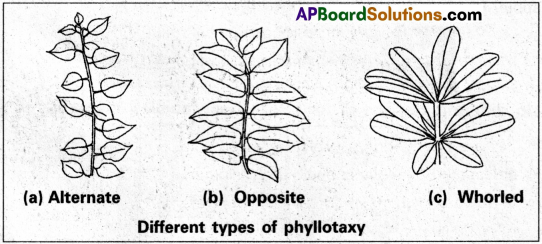
Question 4.
How do leaf modifications help plants?
Answer:
Leaf modifications will help to plants in Many ways. They are
a) In weak stemmed plants like peas, leaves are converted into long, coiled tendrils and help in climbing.
b) In Desert plants like Cacti, leaves are modified into spines, which gave protection from grazing animals.
c) In Onion and Garlic : The fleshy leaves help in storage of food materials.
d) In Australian acacia, the leaves are pinnately compound in which leaflets are small and short lived. The petioles of these plants expand, become green and synthesize food called phyllodes.
e) In Insectivores plants, like Nepenthes, Dionea, leaves are modified into traps which kill insects for their nitrogen requirement.
f) In Bryophyllum, epiphyllous buds which arise from the notches of the leaves develop into new plants, thus help in vegetative Propagation.
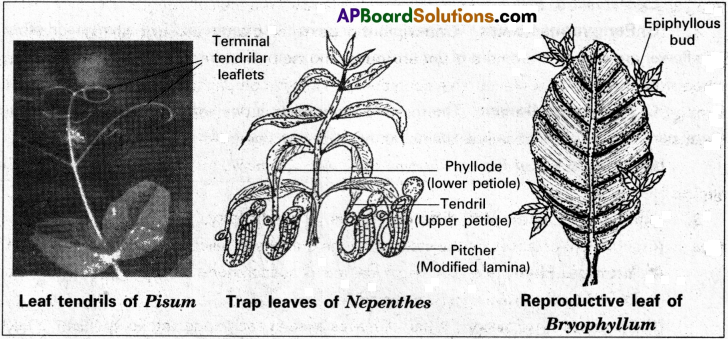
Question 5.
Describe any two special types of Inflorescences.
Answer:
1) Cyathium :
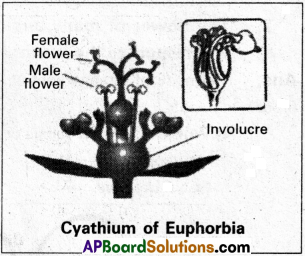
It is a single flower like special inflorescence found in Euphorbiaceae members. The inflorescence is covered by a deep cup like involucre of bracts. At the centre of the cup, there is a single female flower represented by a long stalked tricarpellary, Syncarpous pistil. Encircling this females flower, many male flowers are arranged in scorpioid cymes. Each male flower is represented by a single and stalked stamen. Male and female flowers are achlymadeous. Flowers are arranged in centrifugal manner.
Ex : Euphorbia and Poinsettia
2) Hypanthodium :
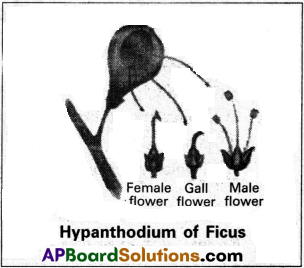
It is a fruit like inflorescence. The inflorescence axis is condensed and forms a fleshy, cup like structure with an apical opening. Small, sessile, unisexual flowers develop on the inner wall of the cup. Male flowers are near the apical opening and female flowers are at the base. In between these two types of flowers, some sterile female flowers called ‘gall flowers’ are present. The opening of flowers is not in a definite order.
Ex : Ficus species.
![]()
Question 6.
Describe the arrangement of floral membes in relation to their insertion on thalamus.
Answer:
Based on the position of Calyx, corolla and androecium on thalamus in respect to the ovary, the flowers are of three types.
They are :
A) Hypogynous,
B) Perigynous,
C) Epigynous
A) Hypogynous flower :
The gynoecium occupies the highest position, while the other parts are situated below it. The ovary is said to be superior.
Ex : Mustard, Brinjal.
B) Perigynous flower :
Gynoecium is present in the centre of the thalamus and other parts of the flower are located on the rim of the thalamus. The ovary is said to be half superior.
Ex : Rose, Pea.
C) Epigynous flower :
The ovary is completely embeded in the cup like thalamus. Other floral parts of the flower arise just above the ovary. In this, the ovary is said to be Inferior.
Ex : Guava, Cucumber.

Question 7.
“The flower of many angiospermic plants which show sepals and petals differe with respect to the arrangement of sepals and petals in respective whorls” – Explain.
Answer:
The mode of arrangement of sepals or petals in floral bud is knwon as Aestivation. It is of 4 types.
A) Valvate :
“When sepals or petals in a whorl just touch one another at the margins without overlapping”.
Ex : Calotropis.

B) Twisted :
“If the margin of the appendage overlaps that of the next one and so on”.
Ex : Cotton, Hibiscus. (Petals).
C) Imbricate :
If the margins of sepals or petals overlap one another but not in any particular direction.
Ex : Cassia, gulmohar.
D) Vexillary :
5 petals are present, of which the largest Petal (standard) overlaps the two lateral petals (Wings) which in turn overlap the two smallest anterior petals (keel). This is known as vexillary or papilionaceous aestivation.
Ex : Pea, Bean.
Question 8.
Describe any four types of placentations found in flowering plants.
Answer:
The arrangement of ovules with in the ovary is known as placentation. It is of 5 types.
A) Marginal :
“The placenta forms a ridge along the ventral suture of the ovary and the ovules are borne on this ridge forming two rows”.
Ex : Pea.
B) Axial :
The ovules are attached to central placenta in a multilocular ovary.
Ex : Tomato, lemon.
C) Parietal :
The ovules develop on the inner wall of the oary. Ovary is one chambered but it becomes two chambered due to the development of flase septum.
Ex : Mustard.
D) Free central :
The ovules are borne on central axis without septa.
Ex : Dianthus.
E) Basal :
The placenta develops at the base of the ovary and a single ovule is attached to it.
Ex : Sunflower.
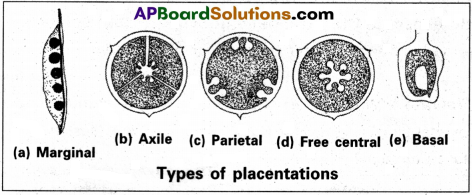
Question 9.
Describe in brief fleshy fruits you studied.
Answer:
Fruits which become fleshy at maturity one are called fleshy fruits. They are 5 types.
1) Berry :
It develops from Bi or multicarpellary syncarpous Gynoecium. The mesocarp and endocarp are fused to form the pulp and the seeds are hard.
Ex : Tomato, Guava.
2) Pepo :
It develops from Tricarpellary syncarpous inferior ovary. The epicarp is rigid, the mesocarp is fleshy and the endocarp is smooth.
Ex : Cucumber.
3) Pome :
It develops from Bi of multicarpellary inferior ovary and is surrounded by fleshy thalamus. The endocarp is cartilegumous.
Ex : Apple.
4) Hesperidium :
It develops from Multicarpellary syncarpous, superior ovary. The epicarp is leathery with volatile giands, Mesocarp is papery and endocarp is several chambered with juicy hairs.
Ex : Citrus.
5) Drupe :
It develops from Monocarpellary superior ovary. In Mango, the epicarp is thin, a middle fleshy edible mesocarp and inner stony hard endocarp. In coconut, the mesocarp is fibrous.
Question 10.
Describe with examples, the various dry fruits you studied.
Answer:
The fruits which become dry at maturity are called Dry fruits. They are of 3 types.
1) Dry dehiscent fruits :
“The fruits which breaks and liberate the seeds”.
Ex : (a) In legumes the fruit dehisces dorsiventrally into two halves and liberate the seeds,
(b) In Cotton, Datura – The capsule dehisce in different ways to liberate the seeds.
2) Dry Indehiscent fruits :
The fruits do not break and liberate the seeds only after the disintegration of pericarp.
Ex : (a) In Rice, The fruit is caryopsis. In this the pericarp and seed coat fuse together.
(b) In Cashew, the fruit is nut, whiph develops from multicarpellary, Syncarpous ovary. The pericarp is stony.
(c) In Tridax, The fruit is cypsela, Identified by the presence of persistent pappus like calyx.
3) Schizocarpic fruits :
“The fruit at maturity split into one – seeded bits called mericarps”.
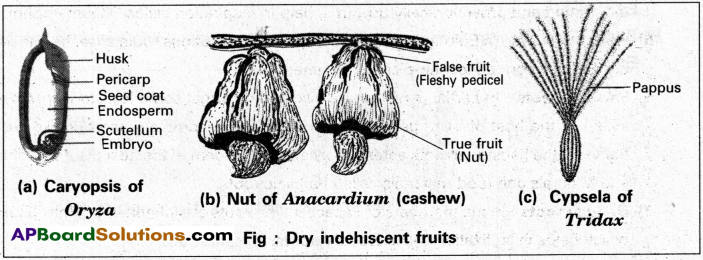
Long Answer Type Questions
Question 1.
Define root. Mention the types of root systems. Explain how root is modified to perform different functions. [A.P & T.S. Mar, 17, 15, 13]
Answer:
The Radicle of the embryo elongates leads to the formation of primary root which grows into the soil is called root. In Angiosperms, two types of root systems are present namely, (a) Tap root system (b) Fibrous root system.
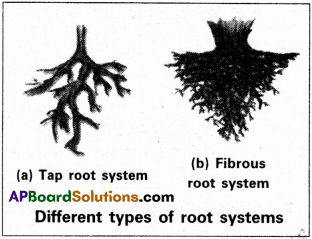
a) Tap root system :
The primary root grows into the soil called tap root, which produce lateral roots and root lets constitutes tap root system. It is seen in Dicotyledonous plants.
b) Fibrous root system :
The primary root is short lived and is replaced by a large number of roots which orginate from the base of the stem constitutes fibrous root system. It is seen in Monocotyledonous plants.
Root Modifications :
In some plants, roots change their shape and structure to perform functions other than absorption and conduction of water and Minerals called root modifications. They are of different types.
1) Storage roots :
In Carrot, turnip (Tap roots), Sweat potato (Adventitious roots), Asparagus (Fibrous roots) become swollen due to storage of food called storage roots.
2) Prop roots :
In Banyan tree, Roots arise from the branches grow into the soil, become pillar like and give additional support called prop roots or pillar roots.
3) Stilt oots :
In Maize, sugarcane, roots arise from the lower nodes of the stem, give additional support called stilt roots.
4) Respiratorty roots :
In Mangroves like Rhizophora and Avicennia, Many roots come out of the ground and grow vertically upwards, help in respiration called Pneumatophores.
5) Epiphytic roots :
In Epiphytes like Vanda, special adventitious roots arise, help in absorption of moisture from almosphere called Velamen roots.
6) Parasitic roots :
In partial parasites like viscum and strga, some Haustorial roots enter into xylem of the host plant to get water and Minerals. In complete parasitic like cuscuta and Rafflesia, the haustorial roots enter into xylem and phloem of the host plant and obtain water and Minerals and food materials called Parasitic roots.
7) Nodular roots :
In the members of Fabaceae, the roots are inhabited by Rhizobium bacteria which helps in N2 fixation called Nodular roots.
8) Photosynthetic roots :
In some plants like Taeniophyllum, the roots are chlorophyllous and perform photosynthesis so called photosynthetic roots.
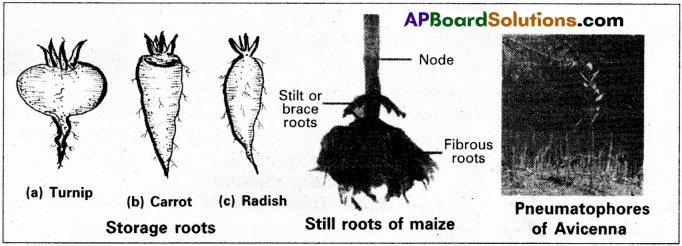

Question 2.
Explain how stem is modified variously to perform different functions. [Mar, 14] [A.P & T.S. Mar, 18]
Answer:
Stems are modified in several ways to perform different functions.
In some plants stem grows into soil, not only stores food materials but also acts as organs of pennations. Such stems are called underground stem modifications. Further, they also help in vegetative propagation.
Ex : The stem tuber of potato, Rhizome of zingiber, corm of colocasia and Bulb of onion.
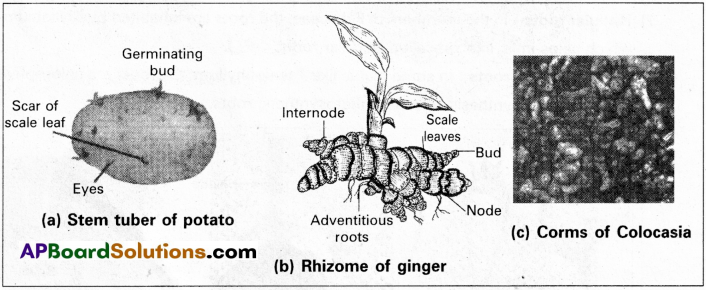

In some plants, Aerial stems show many modifications.
1) Tendrils :
Slender, spirally coiled structures which may develop either from Auxiliary Bud [Cucumber, watermelon] or from Terminal Bud [Grapes] called stem Tendrils, help in climbing.
2) Thorns :
In some plants, buds are modified into woody, straight, pointed thorns, which protect plants from grazing animals.
Ex : Citrus, Bougainvillaea.
3) Phylloclade :
In some plants of arid regions, stems are modified into fleshy flattened (opuntia) or fleshy cylindrical (Euphorbia) or needle like structures (casuarina), called phylloclades. They carry out photosynthesis as their leaves are reduced to scales or spines to reduce the transpiration.
4) Bulbils :
In some plants, the vegetative buds (Diascorea) or floral buds (Agave) store food materials. At maturity they detach from the parent plants, develop adventitious roots and help in vegetative propagation. These are called Bulbils.

In some plants, some part of the stem is aerial and some part is underground. Such stems are called sub aerial stem modifications.
1. Runners :
Sub aerial stems of “oxalis” spread to new niches and form new plants when older parts die. Such plants are called runners.
2. Stolons :
In plants like Nerium, Jasmine, a slender lateral branch called ‘stolon’ arises from the base of the main axis, grow vertically, arches downwards and touch the ground, produce adventitious roots.
3. Off-sets :
In some aquatic plants like pistia and Eichhornia, a lateral branch of one internode length called offset which bears a rosette of leaves at each node and a tuft of adventitious roots arising from the base of the discoid stem.
4. Suckers :
In plants like banana, chrysanthemum, the lateral branches originate from the basal portion of the main stem, grows horizontally, beneath the soil and then come out obliquely upwards giving rise to leafy shoots. These branches are called suckers. All these sub-aerial stem modifications help in vegetative propagation.

Question 3.
Explain different types of Racemos inflorescences.
Answer:
Racemose Inflorescences are of several types. They are :
1) Simple Raceme :
The pedunde is simple, unbranched producing many pedicellate, bracteate flowers in Acropetal Manner.
2) Corymb :
The peduncle is long, and bears many flowers in Acropetal manner, but all the flowers are brought to the same level due to varied lengths of pedicels even through they are borne at different nodes.
Ex : Cassia, Cauliflower.
3) Umbel :
The flower appear to have arisen from the same point of the peduncle and is called umbel type. The Inflorescence is covered by a whorl of bracts called “Involucre”. Ex : Apiaceae, carrot.
4) Spike :
The peduncle is long and bears many sessile flowers, arranged in Aeropetal Manner.
Ex : Achy rant hus, poaceae.
5) Spadix :
In some plants, penduncle bears sessile unisexual and neutral flowers arranged in acropetal manner, covered and protected by modified Bract called spathe.
Ex : Cocos, colocasia.
6) Head :
In some plants, unisexual and bisexual sessile flowers develop centripetially on a condensed peduncle.
Ex : Tridax, sunflower.
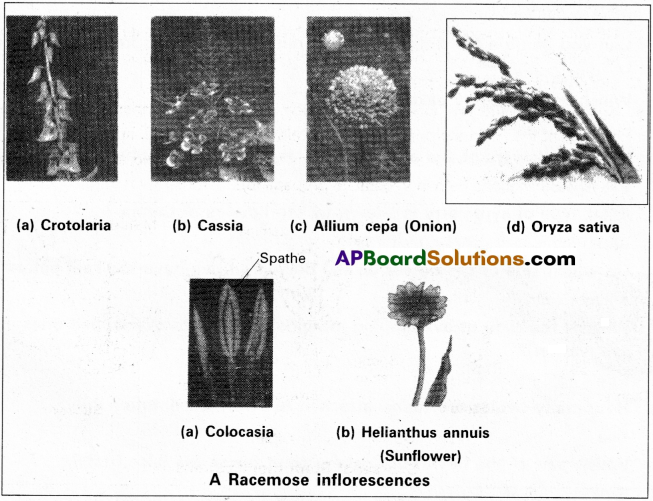
Additional Questions & Answers
Question 1.
What is meant by Scutellum? In which type of seeds it is present?
Answer:
Large and shield shaped cotyledon is known as scutllum. It is seen in Monocot seeds.
![]()
Question 2.
Define with examples endospermic and non-endospermic seeds.
Answer:
Endosperm may be completely consumed by the developing.
embryo before seed maturation. Such seeds are called non-endospermic seeds.
The seeds with endosperm after maturation are called endospermic seeds.
Ex : Castor, Coconut.
Intext Questions
Question 1.
In which plant, the underground stem grows horizontally in soil and helps in perennation?
Answer:
Zingiber officinalis (ginger) – Rhizome.
Curcuma tonga (Turmeric) – Rhizome.
Question 2.
Needle like phylloclades are found in which plant?
Answer:
Casuarina.
Question 3.
Why do plants like Nepenthes trap Insects?
Answer:
Nepenthes generally grow in Nitrogen deficient soils. In this, leaves are modified into pitcher to trap insects for their nitrogen requirement.
Question 4.
What is the characteristic Inflorescence found in members of Asteraceae?
Answer:
Head or Capitulum.
Question 5.
Can you name a plant that has least number of flowers in its inflorescence?
Answer:
Hibiscus, Datura.
Question 6.
Which family shows naked flowers?
Answer:
Euphorbiaceae.
Question 7.
In which flowers of the fig trees does the Insect Blastophaga lay its eggs ?
Answer:
Gall flowers.
Question 8.
What type of symmetry is shown by the flowers of Canna?
Answer:
Asymmetric.
Question 9.
On which side of the flower do the flowers of pea have the keel petals?
Answer:
Anterior side.
Question 10.
What is the ratio of overlapping margins of petals to overlapped ones in imbricate aestivation?
Answer:
5 : 4
Question 11.
How many ovules are found attached in Basal placentation?
Answer:
One
Question 12.
Which part of the flower in Cashew plant forms the false fruit?
Answer:
Pedicel
Question 13.
Which plant has hard, stony endocarp and fleshy edible mesocarp?
Answer:
Mango
Question 14.
What is the morphology of spathe in spadix Inflorescence?
Answer:
Bract (enlarged)
![]()
Question 15.
What is the type of fruit known as if it develops from apocarpus ovary of a single flower?
Answer:
Aggregate fruits. (Anona squamosa)
